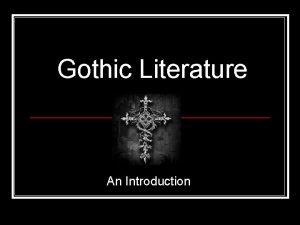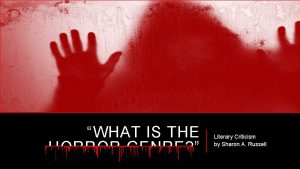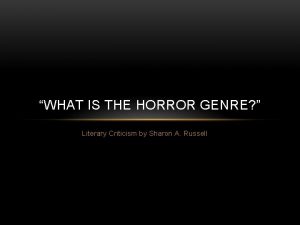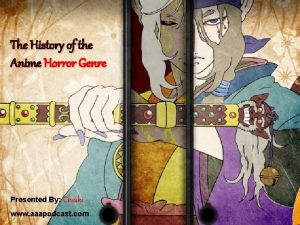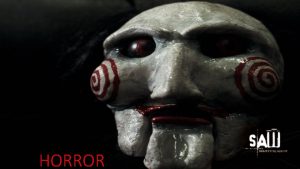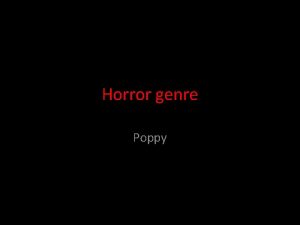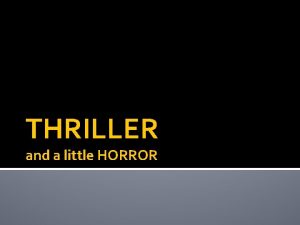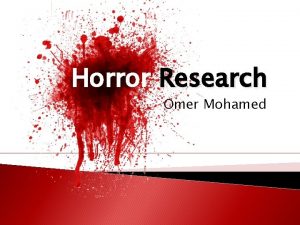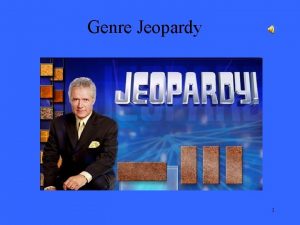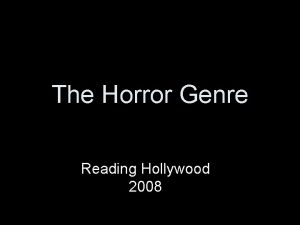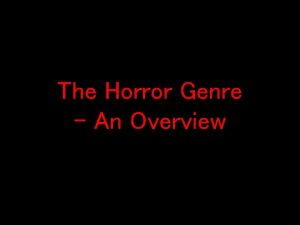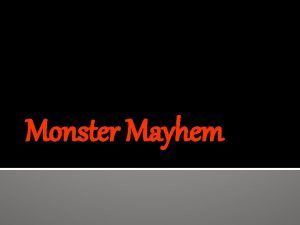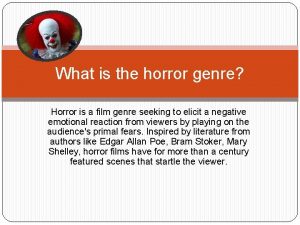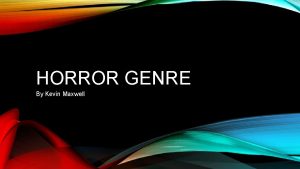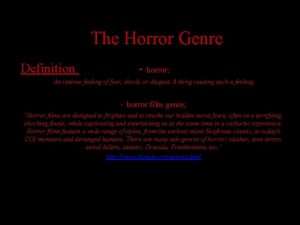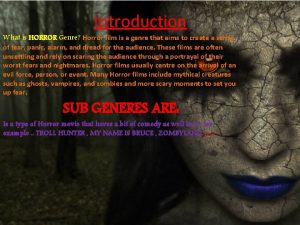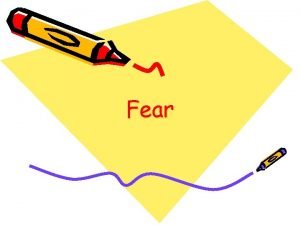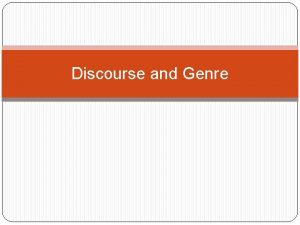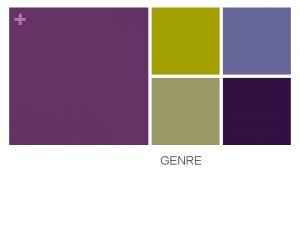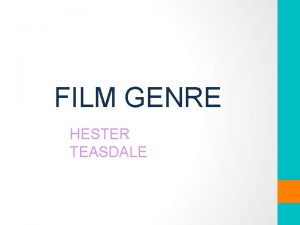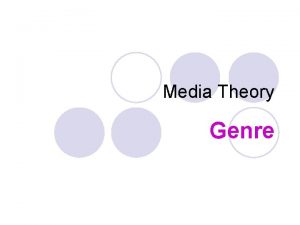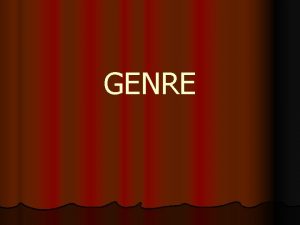Horror Genre Mr Oporta Fear Fear is the



































- Slides: 35

Horror Genre Mr. Oporta

Fear • Fear is the most basic human instinct. • Fear is the most powerful teacher. • Some people love to be scared.

Fear as a Teacher • Origins of the horror genre come from teaching of children. • Parents would often tell stories of children who did not listen to their parents and were taken away by evil spirits. • The Bogeyman

Fear as a Teacher • Malta cave, is a cave somewhere in England. • The cave leads to a system of tunnels that were a labyrinth • Children would play there and get lost, so the parents of a nearby town “created” a monster that lived in the cave and ate children.

Legends • More remote places in Europe would then “readapt” the stories that taught children and enhanced the world those would be “monsters” lived in. • They then became legend and soon people began to believe it.

Legends: Werewolves • At first werewolves were just bigger wolves that lived in the forest and would eat children would wander into the woods alone at night.

Legends: Vampires • Vampires at “first” simply took blood from young/beautiful women to keep them from being promiscuous. • Can be traced as far back as the Ancient Greeks.

Real “Vampires” • Vlad the Impaler, Count of the House of Draculesti. • Prince of Romania what would be Transylvania • He was a fierce warrior and drank the blood of his fallen victims.

Real “Vampires” • The Vampire Countess Lady Bathory she had Anemia • She was obsessed with her looks. • Killed her own servants. • Murdered over 1000 people. • The Servants who escaped told of her story

Vampire Kits

Victorian Horror Stories • Stories were meant to keep woman from being promiscuous • Ankles and wrist considered sex symbols. • Gothic Fiction

Victorian Novels: Gothic Fiction • • Frankenstein The Vampyre The Wolfman Dr. Jeckle and Mr. Hyde • The Invisible man • The Phantom of the Opera

The Horror Genre • The audience experiences/feels fear or disgust. • Stories often have an evil force, event or supernatural character. • Settings are usually in small town America, in quiet neighbourhoods and in woods. • Shadows and darkness play an important part. • The color red is often symbolic.

Horror Through the Ages • Audiences today aren’t easily frightened. Directors need to come up with a new angle or use comedy. • Can you think of any films that have done this successfully?

History of Horror • 1890 s-George Melies’ ‘Monster Movies’ • 1922 -German Vampire Flick • 1930 s-Gothic Horror from Universal Studio (Frankenstein, Dracula) • 1950 -Alien Invasions (Body Snatchers, Thing from another World) • 1960 s-Hammer Films

History of Horror-1960 -1970 s • Late 1960 s-Psychological Horror from Hitchcock (Psycho). Michael Powell’s ‘Peeping Tom’. • Late 60’s-70 s-Occult horror (Rosemary’s Baby, Exorcist)Walking Dead (Romero’s 1968 ‘Night of the Living Dead’. • 1970 s-Gore fests such as Carpenter’s ‘Last House on the Left’, Tobe Hooper’s ‘Texas Chainsaw Massacre’

History of Horror-Late 70 s/80 s • 1978 -Carpenter’s tension filled Halloween. • Romero’s Zombie’s continued to shuffle along in ‘Dawn of the Dead’ and the ‘Day of the Dead’

History of Horror-1990 s • Post-modern, self aware horror from Wes Craven and Kevin Williamson (Scream Trilogy) • 1999 -Blair Witch mockumentary • Japanese Horror floods the market with ‘Ringu’, ‘Ju-On’ (The Grudge)

History of Horror-2000+ • American remakes of Japanese Horror (Ring, Grudge, Dark Waters) • Revisiting of old villains in a new guise (Freddy V Jason, Halloween H 2 O, Alien V Predator).

Characteristics of a Horror • Although all horror films are vastly different and can encompass several different possible plots and endings, there are some characteristics that can be seen in several if not all horror films.

Settings • a deserted (or sparsely inhabited) castle or mansion in a state of ruins or semi-ruins • labyrinths/mazes, dark corridors, and winding stairs

Settings • castles or mansions which have hidden tunnels/staircases, dungeons, underground passages, crypts, or catacombs threatening natural landscapes, like rugged mountains, dark forests, or eerie moors, exhibiting stormy weather

Lighting • Low lit scene • High contrast • limited lighting such as moonlight (usually a full moon), candles, flashlight, lantern

Lighting • often the light disappears: clouds hide the moon, candles go out, flashlights/ lanterns are dropped and broken • if electric lights exist, they usually mysteriously go out

Atmosphere • Dark scenes filled with disturbing shadows and strange and alarming props are typically seen in horror movies. • A characteristic foreboding shot is a tight shot of footsteps coming closer to the main character, who is trying to hide from this threat.

Sound • Horror films typically turn normal sound effects into "creepy" sound elements. • With good timing, a sudden loud bang or a falling object crashing to the floor will deliver a shock factor. • It can also involve a jittery scene set in dead silence, which makes the anticipation of what comes next more hair-raising.

Elements of Horror

Graphic Scenes • Most horror films include graphic scenes of explicit gore • These elements typically feature violence caused by humans, monsters or supernatural beings • The graphic special effects are often used as thrill and climax of films.

Emotional Response • Most horror movies attempt to elicit a specific emotional response. The obvious emotions associated with horror are fear, terror and dread • Horror movies do scare people, whether that fear comes from a supernatural element in the story or knowing that what happened in the film could happen to you. Other emotional elements that come from a horror film include revulsion and a sense of helplessness

Monsters • Although not all films have “monsters” in particular there is always some antagonist that draws the plot forward: EX: Monster, Serial Killer, Evil Spirit etc.

Violence • Violence is, depending on the film, either the climax or plot of the film. • All horror films encompass some form of violence • EX: Saw vs. the Strangers • Saw is considered a “cheap” thrill in violence

Evil Force • ghosts, werewolves, vampires, demons, vicious animals, cannibals, zombies, masked killers and deranged beings.

Other Elements • dark secrets surrounding some tormented soul who is left to live in isolation • ominous omens and curses • magic, supernatural manifestations, or the suggestion of the supernatural • a damsel in distress • the damsel’s rescuer; usually a lover • horrifying (or terrifying) events or the threat of such happenings

What makes Horror, Horrifying? 1. 2. 3. 4. 5. 6. Absence The Unknown The Unexpected The Unbelievable The Unseen The Unconscious The Unstoppable 1. 2. 3. 4. 5. 6. Presence Helplessness Urgency Pressure Intensity Rhythm Release

All Horror is Based on a True Story • • The Amityville Horror The Exorcist Silent Hill Silence of the Lamb
 Gothic story meaning
Gothic story meaning What is the horror genre by sharon russell
What is the horror genre by sharon russell What is the horror genre answer key
What is the horror genre answer key Anime horror genre
Anime horror genre What is horrow
What is horrow Modifiers of human act passion
Modifiers of human act passion Trời xanh đây là của chúng ta thể thơ
Trời xanh đây là của chúng ta thể thơ Số nguyên tố là gì
Số nguyên tố là gì đặc điểm cơ thể của người tối cổ
đặc điểm cơ thể của người tối cổ Tỉ lệ cơ thể trẻ em
Tỉ lệ cơ thể trẻ em Phối cảnh
Phối cảnh Các châu lục và đại dương trên thế giới
Các châu lục và đại dương trên thế giới ưu thế lai là gì
ưu thế lai là gì Hệ hô hấp
Hệ hô hấp Kể tên các môn thể thao
Kể tên các môn thể thao Tư thế ngồi viết
Tư thế ngồi viết Cái miệng nó xinh thế
Cái miệng nó xinh thế Hát kết hợp bộ gõ cơ thể
Hát kết hợp bộ gõ cơ thể Mật thư anh em như thể tay chân
Mật thư anh em như thể tay chân Tư thế ngồi viết
Tư thế ngồi viết Voi kéo gỗ như thế nào
Voi kéo gỗ như thế nào Thẻ vin
Thẻ vin Thế nào là giọng cùng tên?
Thế nào là giọng cùng tên? Thể thơ truyền thống
Thể thơ truyền thống Các châu lục và đại dương trên thế giới
Các châu lục và đại dương trên thế giới Từ ngữ thể hiện lòng nhân hậu
Từ ngữ thể hiện lòng nhân hậu Hổ đẻ mỗi lứa mấy con
Hổ đẻ mỗi lứa mấy con Thế nào là hệ số cao nhất
Thế nào là hệ số cao nhất Diễn thế sinh thái là
Diễn thế sinh thái là Vẽ hình chiếu vuông góc của vật thể sau
Vẽ hình chiếu vuông góc của vật thể sau Slidetodoc
Slidetodoc Làm thế nào để 102-1=99
Làm thế nào để 102-1=99 Lời thề hippocrates
Lời thề hippocrates Tư thế worm breton
Tư thế worm breton đại từ thay thế
đại từ thay thế Quá trình desamine hóa có thể tạo ra
Quá trình desamine hóa có thể tạo ra
